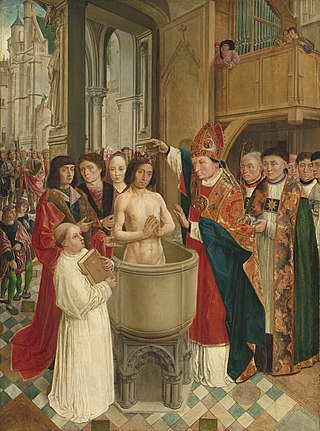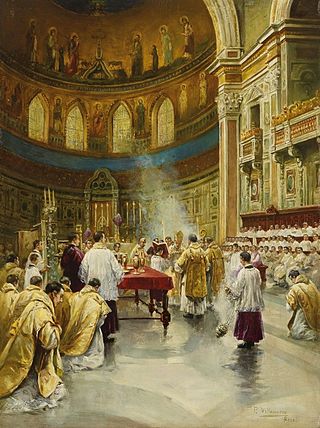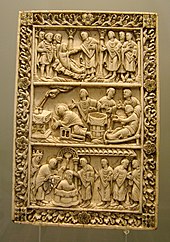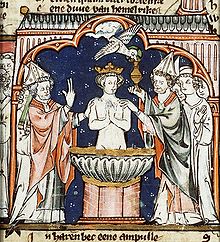
Clovis was the first king of the Franks to unite all of the Frankish tribes under one ruler, changing the form of leadership from a group of petty kings to rule by a single king and ensuring that the kingship was passed down to his heirs. He is considered to have been the founder of the Merovingian dynasty, which ruled the Frankish kingdom for the next two centuries. Clovis is important in the historiography of France as "the first king of what would become France".

Reims is the most populous city in the French department of Marne, and the 12th most populous city in France. The city lies 129 km (80 mi) northeast of Paris on the Vesle river, a tributary of the Aisne.

Anointing is the ritual act of pouring aromatic oil over a person's head or entire body.

Chrism, also called myrrh, myron, holy anointing oil, and consecrated oil, is a consecrated oil used in the Catholic, Eastern Orthodox, Oriental Orthodox, Assyrian, Nordic Lutheran, Anglican, and Old Catholic churches in the administration of certain sacraments and ecclesiastical functions.

The French Crown Jewels and Regalia comprise the crowns, orb, sceptres, diadems and jewels that were symbols of Royal or Imperial power between 752 and 1870. These were worn by many Kings and Queens of France as well as Emperor Napoleon. The set was finally broken up, with most of it sold off in 1885 by the Third Republic. The surviving French Crown Jewels, principally a set of historic crowns, diadems and parures, are mainly on display in the Galerie d'Apollon of the Louvre, France's premier museum and former royal palace, together with the Regent Diamond, the Sancy Diamond and the 105-carat (21.0 g) Côte-de-Bretagne red spinel, carved into the form of a dragon. In addition, some gemstones and jewels are on display in the Treasury vault of the Mineralogy gallery in the National Museum of Natural History.

Remigius was the Bishop of Reims and "Apostle of the Franks". On 25 December 496, he baptised Clovis I, King of the Franks. The baptism, leading to about 3000 additional converts, was an important event in the Christianization of the Franks. Because of Clovis's efforts, a large number of churches were established in the formerly pagan lands of the Frankish empire, establishing a distinctly Orthodox variety of Christianity for the first time in Germanic lands, most of whom had been converted to Arian Christianity.

The Archdiocese of Reims or Rheims is a Latin Church ecclesiastic territory or archdiocese of the Catholic Church in France. Erected as a diocese around 250 by Sixtus of Reims, the diocese was elevated to an archdiocese around 750. The archbishop received the title "primate of Gallia Belgica" in 1089.

An ampoule is a small sealed vial which is used to contain and preserve a sample, usually a solid or liquid. Ampoules are usually made of glass.

The Chrism Mass is a religious service held in certain Christian denominations, such as Roman Catholicism, Lutheranism, and Anglicanism. It is usually celebrated each year on Maundy Thursday or on another day of Holy Week. During the ceremony, the holy oils used for sacraments and rituals are blessed or consecrated.

Tilpin, Latin Tilpinus, also called Tulpin, a name later corrupted as Turpin, was the bishop of Reims from about 748 until his death. He was for many years regarded as the author of the legendary Historia Caroli Magni, which is thus also known as the "Pseudo-Turpin Chronicle". He appears as one of the Twelve Peers of France in a number of the chansons de geste, the most important of which is The Song of Roland. His portrayal in the chansons, often as a warrior-bishop, is completely fictitious.

The Oil of Catechumens, also known as the Oil of Exorcism, is the oil used in some traditional Christian churches during baptism; it is believed to strengthen the one being baptized to turn away from evil, temptation and sin.

The Musée Saint-Remi is an archeology and art museum in Reims, France. The museum is housed in the former Abbey of Saint-Remi, founded in the sixth century and which had been keeping since 1099 the relics of Saint Remigius. The Basilica of Saint-Remi, adjacent to it and consecrated in 1049, was its abbey church. Both buildings have been listed as part of a UNESCO World Heritage Site since 1991 because of their outstanding architecture and importance in the early French monarchy.

Nicolas de Thou was a French prelate of the Catholic Church. He was a cleric, Bishop of Chartres, and, in politics, a figure instrumental in the coronation of Henry IV of France, the first monarch of the Bourbon dynasty in France.

The Diocese of Soissons, Laon, and Saint-Quentin is a Latin Church diocese of the Catholic Church in France. The diocese is suffragan to the Archdiocese of Reims and corresponds, with the exception of two hamlets, to the entire Department of Aisne. The current bishop is Renauld Marie François Dupont de Dinechin, appointed on 30 October 2015. In the Diocese of Soissons there is one priest for every 4,648 Catholics.

The accession of the King of France to the royal throne was legitimized by a ceremony performed with the Crown of Charlemagne at the Reims Cathedral. In late medieval and early modern times, the new king did not need to be anointed in order to be recognized as French monarch but ascended upon the previous monarch's death with the proclamation "Le Roi est mort, vive le Roi!"

Napoleon and Joséphine were crowned Emperor and Empress of the French on Sunday, December 2, 1804, at Notre-Dame de Paris in Paris. It marked "the instantiation of [the] modern empire" and was a "transparently masterminded piece of modern propaganda".

Notre-Dame de Reims, known in English as Reims Cathedral, is a Roman Catholic cathedral in the French city of the same name, the archiepiscopal see of the Archdiocese of Reims. The cathedral was dedicated to the Virgin Mary and was the traditional location for the coronation of the kings of France. Reims Cathedral is considered to be one of the most important pieces of Gothic architecture. The cathedral, a major tourist destination, receives about one million visitors annually. It became a UNESCO World Heritage Site in 1991.
Wenilo was the archbishop of Sens from 836 or 837. Prior to becoming bishop, Wenilo was a palatine chaplain. As bishop, he was one of the leading men in Aquitaine and crowned Charles the Bald king in 848, definitively uniting Aquitaine with West Francia. In 858, he supported the East Frankish invasion and was denounced as a traitor by the king. They reconciled the next year, and Wenilo retained his office until his death. Nevertheless, he passed into legend as Ganelon, the archvillain of the Matter of France, his name a byword for "traitor".

Christianization of the Franks was the process of converting the pagan Franks to Catholicism during the late 5th century and early 6th century. It was started by Clovis I, regulus of Tournai, with the insistence of his wife, Clotilde and Saint Remigius, the bishop of Reims.
Les Rois thaumaturges: Étude sur le caractère supernaturel attribué à la puissance royale particulièrement en France et en Angleterre is a work by historian Marc Bloch first published in 1924. It deals with the miraculous powers attributed to the Kings of France and the Kings of England, the most famous of which is the healing of scrofula by touch. Also known as the King's Evil, it was "an extremely frequent and dreaded ailment in Europe at the time". This is a groundbreaking book, as its approach draws on historical anthropology, Marc Bloch introduced anthropology, history of mentalities and comparative history into historical studies, heralding the historiographical revolution of the Annales.




















